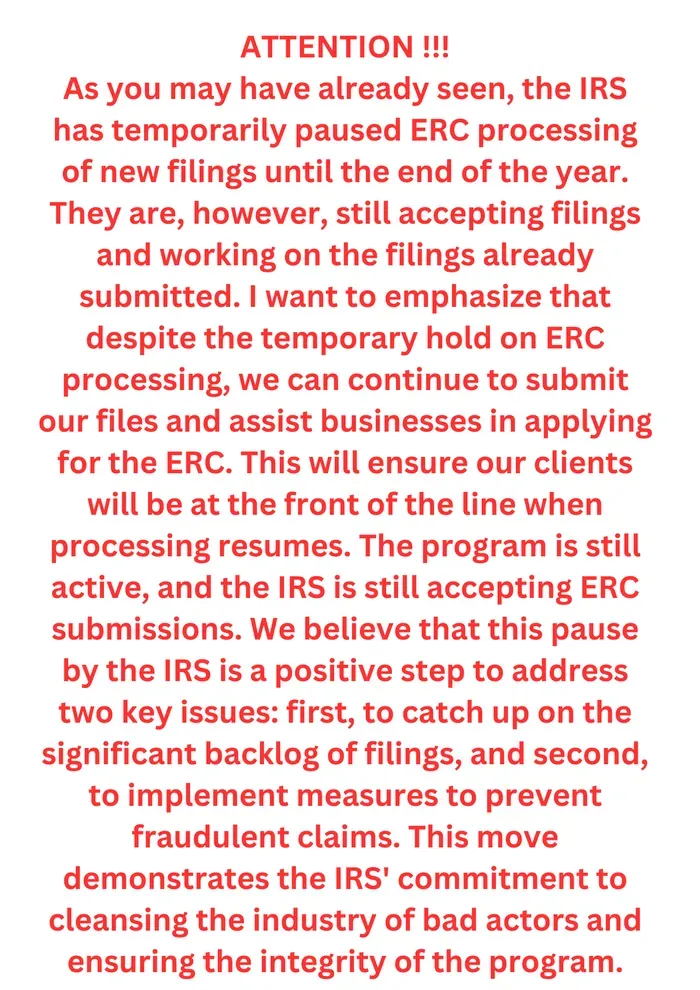

For many churches and nonprofit organizations, the employee retention credit has been an essential financial lifeline during the pandemic. This article discusses the eligibility criteria, requirements, and benefits of the ERC for these entities. Additionally, it explores how to claim this valuable tax credit and avoid potential issues with the Internal Revenue Service.

The employee retention credit is designed to help businesses and organizations financially impacted by COVID-19. Instituted in 2020 and extended into 2021, the ERC includes changes such as increased eligibility of businesses, nonprofits, and churches. Its goal is to incentivize employers to retain employees during the pandemic, thereby supporting not only the individual entities but also the broader economy.
Churches and non-profit organizations can indeed qualify for the ERC. Like other eligible organizations, they must demonstrate a significant decline in gross receipts or operations fully or partially suspended by a government order. Churches and nonprofits that were affected by the pandemic can use this tax credit as a financial mechanism to maintain full-time employees.
One point of concern for some organizations is the interplay between the Paycheck Protection Program (PPP) loan and the employee retention credit. Originally, entities that took a PPP loan were not eligible for the ERC. However, as of the December 2020 relief bill, organizations may now qualify for both, effectively appearing as separate recipients on their tax return.
To claim the ERC, churches and nonprofits must show a significant decline in gross receipts in 2020 or 2021 compared to the corresponding quarter in 2019. For example, if gross receipts were 50% lower in the second quarter in 2020 than in the second quarter of 2019, this would qualify as a significant decline.
Alternatively, organizations might qualify for the credit when their operations were fully or partially suspended due to a government order resulting from COVID-19. If your church or nonprofit had to close, limit hours, or reduce capacity by government mandate, it might qualify for the ERC.
Qualified wages for the employee retention credit include salaries, wages, and certain costs related to health benefits. Employers need to consider eligible wages paid to employees during the periods affected by the pandemic. The specific amounts for qualified wages vary based on the number of staff and the total amount of wages paid during that time.
The amount of the ERC depends on varying factors, but the per employee maximum credit calculation typically includes a percentage of qualified wages paid to each employee up to a specific limit. The maximum credit differed between 2020 and 2021, so it is essential to consider each year's limitations.
The maximum employee retention credit for churches and nonprofits differed by quarter in 2020 and 2021. Changes in Congress's updated relief package affected the benefits for each entity. Keep in mind the specific rates and limitations when claiming the credit for your organization.
While both PPP loans and the employee retention credit provide financial aid, there are crucial differences between the two. Whereas PPP loans focus on providing low-interest loans for businesses to maintain payroll during economic crisis, the ERC targets organizations that have experienced a significant decline in gross receipts, with non-repayable tax credits aimed at employee retention.
Nonprofits and churches can claim the ERC by filing their quarterly payroll tax return on Form 941. This form has been updated to include the required information for calculating and reporting the ERC. Ensuring the accurate calculation of qualified wages is essential to maximizing the benefits of the ERC.
If your church or nonprofit determines that it was eligible for the ERC in a previously filed quarter, it can apply for the credit by amending the relevant Form 941 with Form 941-X. Note that organizations must make adjustments to employee wages and tax credits to ensure accurate reporting.
Churches and non-profit organizations that qualify for the ERC can receive tax credits applied against their payroll tax liability, with any excess credit refunded or applied to future payroll tax liabilities. This refund or advance payment can be obtained by filing Form 7200 before the Form 941 is due.
When claiming the employee retention credit, it is vital to keep extensive records of eligibility requirements and qualified wages. Keeping proper documentation will help if the Internal Revenue Service audits your church or organization, ensuring a smoother process and reducing the risk of any penalties.
To avoid potential issues with the IRS, organizations must comply with guidelines for claiming the credit. This includes accurately determining eligibility, qualified wages, and correctly filing appropriate forms. Additionally, it is wise to be informed of any changes or updates to the ERC program.
Given the complex nature of the ERC program and its impact on organizations, seeking professional assistance with ERC eligibility and applications can ensure that your church or nonprofit maximizes its tax credit benefits. Consulting with experts who understand tax regulations and intricate legislation can help clarify the path to claiming and benefiting from the ERC.
In conclusion, the employee retention credit (ERC) has been a lifeline for many churches and nonprofit organizations impacted by the pandemic. This article has discussed the eligibility criteria, requirements, and benefits of the ERC, focusing on its importance for entities affected by COVID-19.
Churches and nonprofit organizations that have experienced a significant decline in gross receipts or had their operations fully or partially suspended by government orders can use the ERC to maintain full-time employees.
Additionally, the article has explored how to claim the ERC and avoid potential issues with the IRS by complying with guidelines for claiming the credit and seeking professional assistance with ERC eligibility and applications.
Overall, the ERC provides significant tax credit benefits to churches and nonprofit organizations, making it a valuable financial mechanism during these challenging times.
© 2023 Ercforchurches.org. All Rights Reserved.